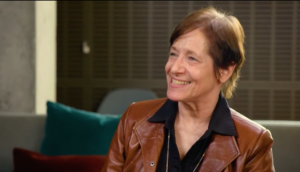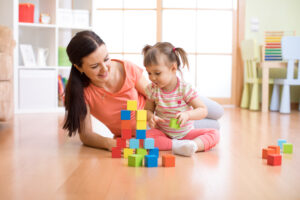
Types of Play & Why They Matter
An excerpt from a behind-the-scenes interview with Dr. Kathy Hirsh-Pasek at the 2018 Simms/Mann Institute Think Tank
The term “transitional object” was originally coined by Winnicott (1951, 1953) to describe the soft, clingable objects infants and young children become attached to (e.g., soft blankets or teddy bears). These object attachments decrease distress and anxiety while providing comfort and security for young children during separations from the parent. Winnicott described these objects as a substitute for the mother and her caregiving qualities in her absence. As a representation of the bond with the mother, the transitional object was conceived as “bridge” between the child’s inner world (e.g., the attachment bond) and the outer world (e.g., the reality of having to cope with separations from her).

Studies of the meanings that certain objects hold for their owner across the lifespan suggest that inanimate objects embody a multitude of meanings and functions not only for children but also for parents throughout their adult years (e.g., as “holders” of memories, links to one’s past and personal history, sources of comfort, and symbols of the self and one’s roles). These studies suggest that objects which adults tend to hold the most dear are those that symbolize or remind their owner of important social bonds or ties (e.g., Kamptner, 1989a, 1989b, 1991, 1994).
Clinical studies of adults’ use of transitional objects also report that certain objects come to function as physical embodiments of a significant person, and that physically touching or seeing that object strengthens the owner’s awareness of the other person and allows them to “hold” in their mind the sense or image of the person during separations (e.g., Arthern & Madill, 1999, 2002). By evoking feelings of connectedness, the object becomes an emotional “link” to the other person. As a result, feelings of love, comfort, and emotional closeness are experienced– thereby lessening the pain and anxiety of separation as we “feel” the other person’s presence. A wedding ring, for example, is often described by its owner as a reminder of a significant other. And as I sit writing this, NPR is interviewing a woman participating in the protest after the presidential inauguration who said she was wearing two wedding rings: one each from her deceased mother and grandmother as she wanted them both with her today.
Transitional objects may be especially helpful to parents who must endure separations from their young children. Having a special object to touch, see, and hold can be a visual and physical reminder of, and an emotional connection to, a young child. Such an object may help a parent “feel” their baby’s presence and re-experience emotional closeness to their baby in their absence, thereby comforting and calming a parent, and minimizing their anxiety and distress. (One mother, for example, described to me several years ago how when her children were babies and she had to work the night shift, she kept a pair of socks from each of them in her pocket to comfort herself and manage the separation).
A transitional object that is soft may further contribute to creating positive relational emotions as studies have found that regardless of age, touching or holding soft objects is comforting, stress-reducing, and calming. (Touching soft things may release opiods in the brain, increase oxytocin levels to induce positive emotions, and reduce the stress hormone cortisol, e.g., Koga & Iwasaki, 2013; McDaniel & Anderson, 1998; Panksaap, 2004; Sumioka et al., 2013; Tai, Zheng, & Narayanan, 2011).
Minimizing a parent’s stress and anxiety during separations can help lessen the stress a parent brings home as parent stress “hijacks” the parent brain: it decreases one’s capacity to be warm, sensitively attuned, and responsive toward others. Stress also has an adverse effect on the brain’s chemical reward system, diminishes self-awareness, and negatively impacts emotion regulation (e.g., Hughes & Baylin, 2012; Siegel & Bryson, 2012). Stress makes us go “lower brain”, hurting our interactions with our children.
As Winnicott described so many years ago, transitional objects act as a “bridge” between the “inner emotional world” and the challenges brought about by managing and coping with the day-to-day realities of one’s environment (i.e., the “outer world”). Separations from loved ones are difficult for everyone, but transitional objects may help mitigate the distress for both children and adults.

An excerpt from a behind-the-scenes interview with Dr. Kathy Hirsh-Pasek at the 2018 Simms/Mann Institute Think Tank

As parents, we get so much feedback about what we can do to enhance our baby’s development. Sometimes, it can be difficult to remember one

Children thrive when they are provided with a predictable, structured environment. Routines provide a sense of safety and security, as well as foster healthy emotional and

As parents, we get so much feedback about what we can do to enhance our baby’s development. Sometimes, it can be difficult to remember one

Children thrive when they are provided with a predictable, structured environment. Routines provide a sense of safety and security, as well as foster healthy emotional and

Just think of how much time babies spend in routines of one kind or another: sleeping, bathing, feeding, and diaper changing, not to mention dressing,

An excerpt from a behind-the-scenes interview with Dr. Kathy Hirsh-Pasek at the 2018 Simms/Mann Institute Think Tank

As parents, we get so much feedback about what we can do to enhance our baby’s development. Sometimes, it can be difficult to remember one
| Cookie | Duration | Description |
|---|---|---|
| __stripe_mid | 1 year | Stripe sets this cookie cookie to process payments. |
| __stripe_sid | 30 minutes | Stripe sets this cookie cookie to process payments. |
| cookielawinfo-checkbox-advertisement | 1 year | Set by the GDPR Cookie Consent plugin, this cookie is used to record the user consent for the cookies in the "Advertisement" category . |
| cookielawinfo-checkbox-analytics | 11 months | This cookie is set by GDPR Cookie Consent plugin. The cookie is used to store the user consent for the cookies in the category "Analytics". |
| cookielawinfo-checkbox-functional | 11 months | The cookie is set by GDPR cookie consent to record the user consent for the cookies in the category "Functional". |
| cookielawinfo-checkbox-necessary | 11 months | This cookie is set by GDPR Cookie Consent plugin. The cookies is used to store the user consent for the cookies in the category "Necessary". |
| cookielawinfo-checkbox-others | 11 months | This cookie is set by GDPR Cookie Consent plugin. The cookie is used to store the user consent for the cookies in the category "Other. |
| cookielawinfo-checkbox-performance | 11 months | This cookie is set by GDPR Cookie Consent plugin. The cookie is used to store the user consent for the cookies in the category "Performance". |
| CookieLawInfoConsent | 1 year | Records the default button state of the corresponding category & the status of CCPA. It works only in coordination with the primary cookie. |
| elementor | never | This cookie is used by the website's WordPress theme. It allows the website owner to implement or change the website's content in real-time. |
| viewed_cookie_policy | 11 months | The cookie is set by the GDPR Cookie Consent plugin and is used to store whether or not user has consented to the use of cookies. It does not store any personal data. |
| Cookie | Duration | Description |
|---|---|---|
| mailchimp_landing_site | 1 month | The cookie is set by MailChimp to record which page the user first visited. |
| Cookie | Duration | Description |
|---|---|---|
| _ga | 2 years | The _ga cookie, installed by Google Analytics, calculates visitor, session and campaign data and also keeps track of site usage for the site's analytics report. The cookie stores information anonymously and assigns a randomly generated number to recognize unique visitors. |
| _gat_gtag_UA_46801669_2 | 1 minute | Set by Google to distinguish users. |
| _gid | 1 day | Installed by Google Analytics, _gid cookie stores information on how visitors use a website, while also creating an analytics report of the website's performance. Some of the data that are collected include the number of visitors, their source, and the pages they visit anonymously. |
| tk_lr | 1 year | The tk_lr is a referral cookie set by the JetPack plugin on sites using WooCommerce, which analyzes referrer behaviour for Jetpack. |
| tk_or | 5 years | The tk_or is a referral cookie set by the JetPack plugin on sites using WooCommerce, which analyzes referrer behaviour for Jetpack. |
| tk_r3d | 3 days | JetPack installs this cookie to collect internal metrics for user activity and in turn improve user experience. |
| tk_tc | session | JetPack sets this cookie to record details on how user's use the website. |
| Cookie | Duration | Description |
|---|---|---|
| cookies.js | session | No description available. |
| m | 2 years | No description available. |